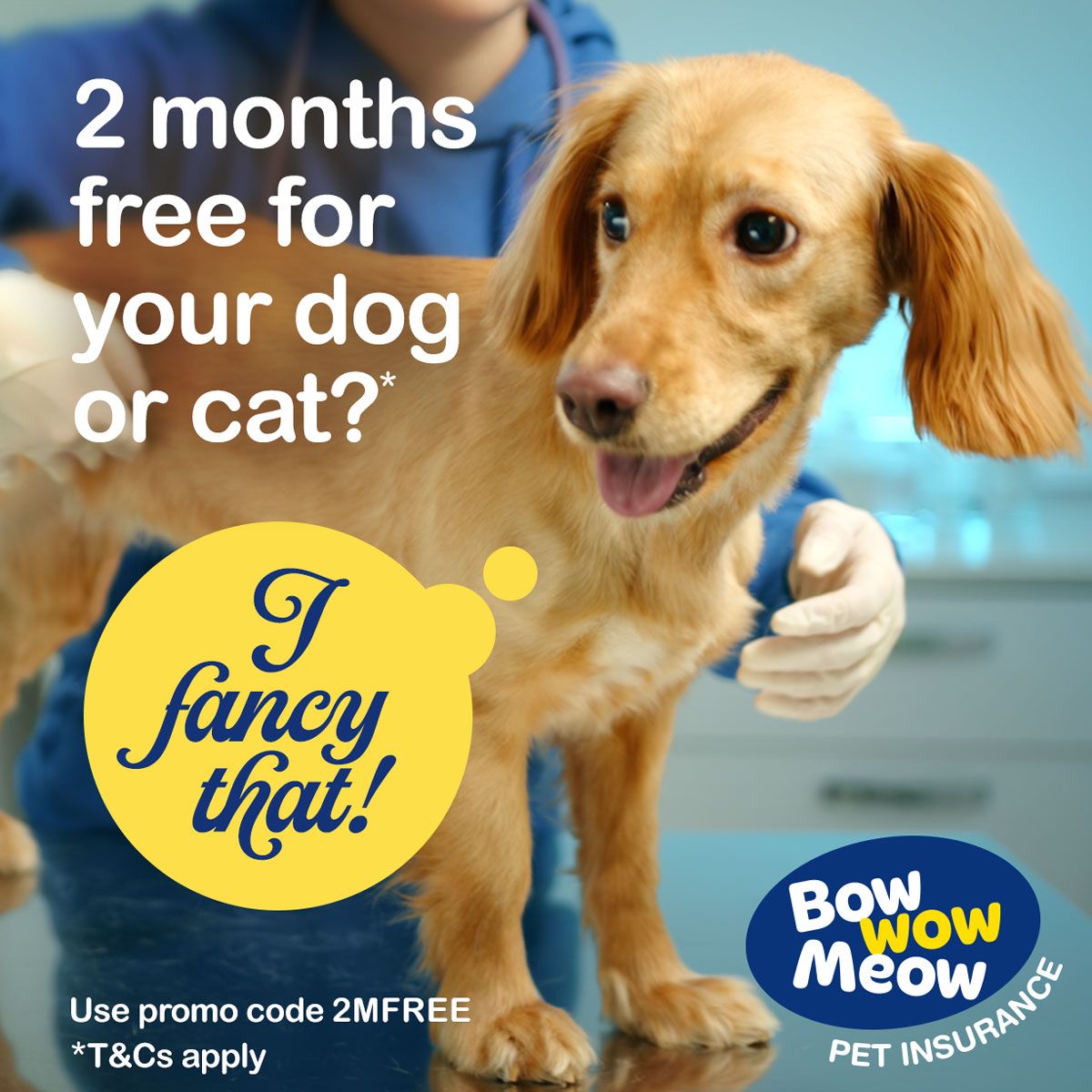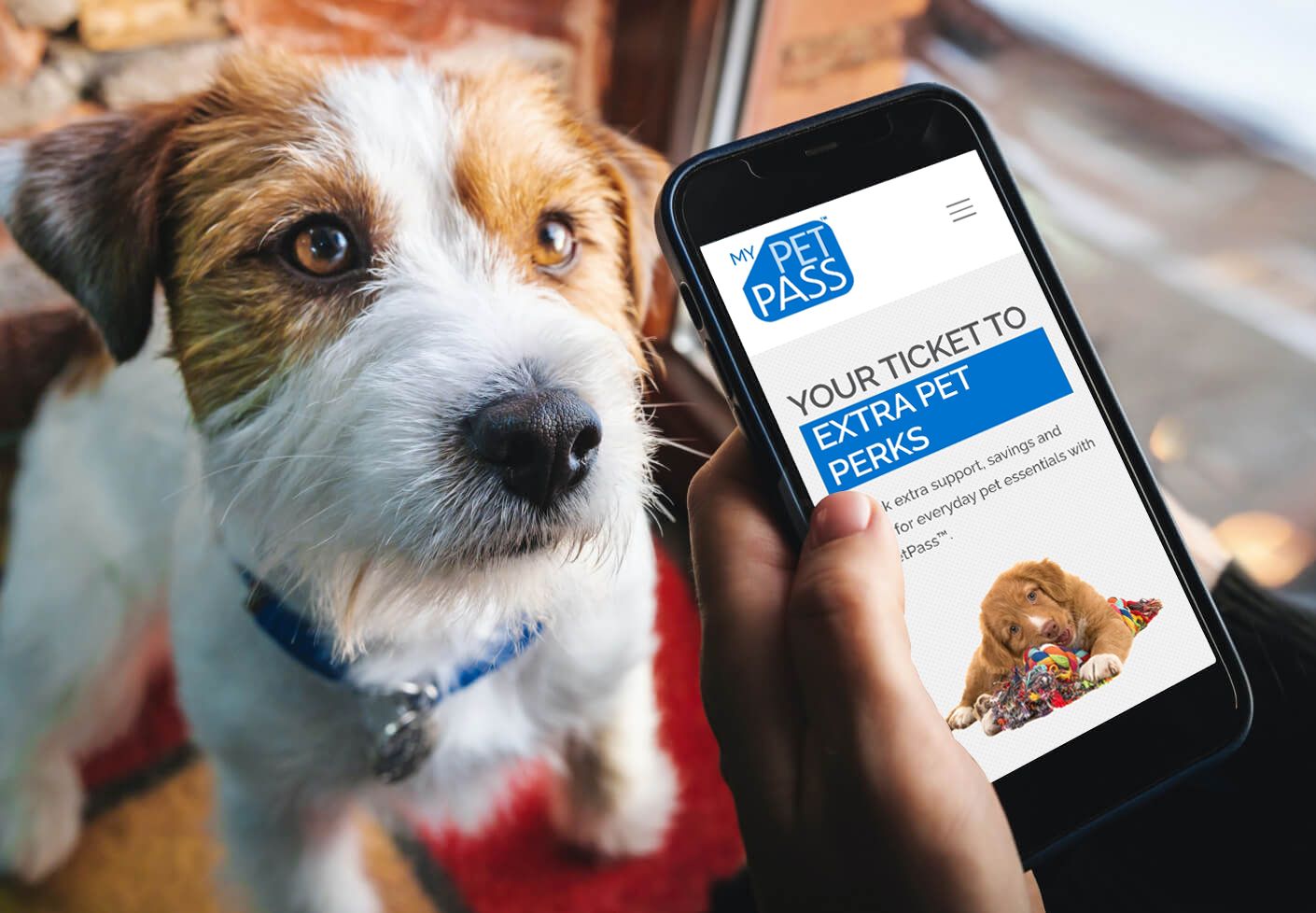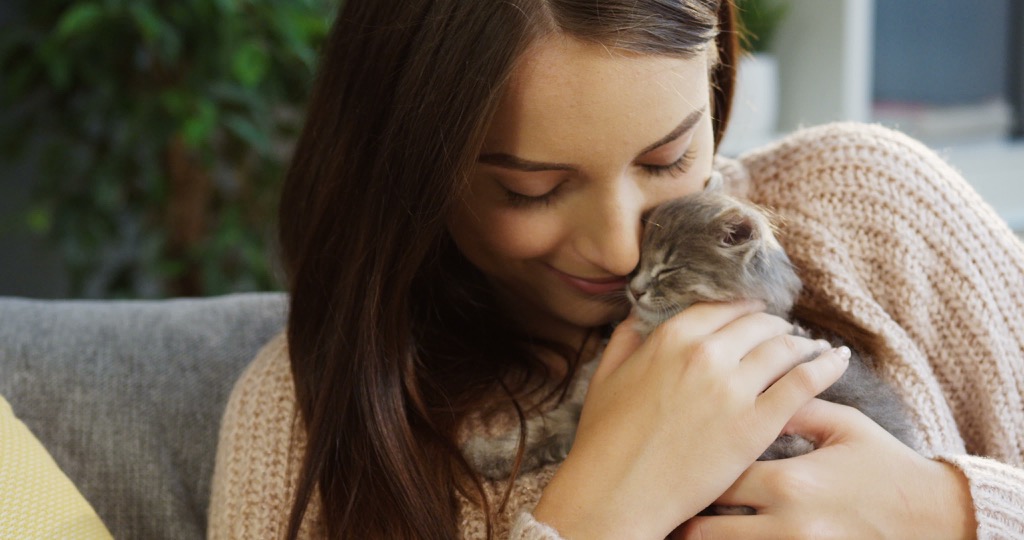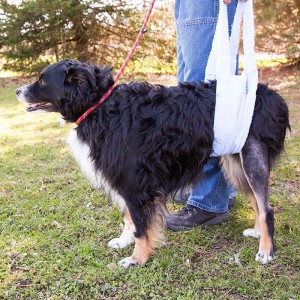Cardiac disease in cats
What is cardiac disease in cats?
The heart and blood vessels (arteries and veins) are part of the cardiovascular system. The heart is a hollow, muscular organ which in cats and other mammals is divided into four chambers. There are two upper chambers, called the left atrium and right atrium, and two lower chambers, called the left and right ventricles. The heart’s function is to pump blood around the body: the right side pumps blood to the lungs and the left side pumps blood to the rest of the body. A series of valves maintain blood flow in one direction through the heart.
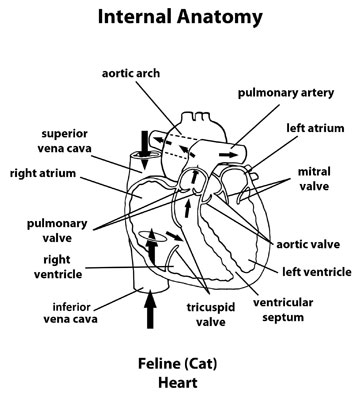
Feline heart, external anatomy. Source: https://www.cathealth.com/images/stories/CatHealth/Health/Feline_internal_anatomy_of_heart_flow_in.jpg
Feline cardiac or heart disease is the silent killer of cats. One in six cats can be born with or develop heart disease in its lifetime. Heart disease can be broadly defined as any abnormality of the heart, and therefore includes a wide range of conditions, from congenital abnormalities to functional, structural, or electrical abnormality of the heart. Heart disease can affect any of the components of the heart, including the external heart sac (the pericardium), the actual heart muscle (myocardium) and the inner layer of cells (endocardium).
Heart disease can be classified according to a range of characteristics:
- Congenital (present at birth or near birth) or acquired (develop over time and with age)
- Infectious or degenerative
- Duration – long term or short term
- Clinical status – e.g. left heart failure, biventricular failure
- Physical structure malformation – e.g. ventricular septal defect
- Electrical disturbance – e.g. atrial fibrillation
Hypertrophic cardiomyopathy (HCM)
Cardiomyopathy is a term used to describe diseases of the heart muscle. In cats, three types of cardiomyopathy have been identified: hypertrophic, dilated and restrictive cardiomyopathy. The most common acquired heart disease in cats is hypertrophic cardiomyopathy (HCM). It is estimated that more than 85% of cats with heart disease have hypertrophic cardiomyopathy.
Hypertrophic cardiomyopathy is an abnormal thickening of the heart muscle, specifically the left ventricle, which is the main pumping chamber of the heart. This thickening, or hypertrophy, impairs the ability of the heart walls to stretch and fill with adequate amounts of blood to pump to the body. Fluid then backs up in the tissues, particularly the lungs. This can lead to congestive heart failure, clot formation and even sudden death in severely affected cats.
Hypertrophic cardiomyopathy has been associated with a genetic mutation in Maine Coon and Ragdoll cats, and a genetic predisposition is suspected in other breeds and mixed breed cats. Middle aged (5 to 7 years) cats are typically affected, however, the disease may develop at a young age or advanced age in some cats. Males are most often affected.
A smaller number of cats will have dilated cardiomyopathy, in which the heart muscle becomes enlarged, although this condition is more commonly associated with heart disease in dogs and subsequent congestive heart failure in dogs.
Also less common is restrictive cardiomyopathy, in which the heart walls are stiffer than normal, and unclassified cardiomyopathy. Often cats will have an intermediate form which can be a combination of the above forms.
Other feline heart diseases and heart conditions
- Structural inflammatory conditions: endocarditis, myocarditis, and pericarditis, resulting from a variety of causes, including infectious, traumatic, and immune conditions.
- Pericardial effusion, where excessive fluid collects between the heart and the sac (pericardium) surrounding the heart; its causes are diverse and while many are not harmful, they can make the heart work poorly.
- Valvular diseases, or damage to one of the four valves of the heart, such as valvular endocardiosis, valvular degeneration, and valvular regurgitation/insufficiency.
- Aortic thromboembolism (ATE), a complication of advanced heart disease in cats, where blood clots form and travel through the body, becoming lodged in the femoral arteries (the main arteries carrying blood to the hind legs). Blood flow to the hind limbs is reduced, causing pain, cold limbs, decreased pulse and paralysis.
Heart murmur
A heart murmur is an extra vibration in the heart beat, which may be detected by the vet during a physical examination. Heart murmurs usually develop from a disturbance in the blood flow. Heart murmurs are identified in patients with and without heart disease. Many murmurs are innocent, particularly the soft murmurs identified in young kittens without any evidence of cardiac disease, and these usually disappear on their own. Pathologic murmurs often have very characteristic sounds and are associated with structural heart disease.
Other benign murmurs are sometimes discovered secondary to anaemia (decreased red blood cell count), pain, and intense excitement. Heart murmurs in older cats are generally caused by hyperthyroidism or hypertension.
Heart failure in cats
Heart failure in cats is any heart abnormality or cardiac disease that results in the inability of the heart to pump enough blood to meet the body’s needs. Heart failure is therefore the consequence of severe heart disease, but it is important to note that not all heart diseases lead to heart failure.
A cat showing signs of having too little blood in the tissues to sustain normal function is said to be in low output heart failure. A cat showing signs caused by blood damming up in poorly drained organs, is said to be in congestive heart failure.
Congestive heart failure (CHF)
- Can be caused by a failure on the left, right or both sides of the heart.
- Is so named because when the heart is unable to pump enough blood to the lungs, fluid backs up into them, causing congestion of the lung tissue.
- Can occur at any age, in any breed, and either gender, but it happens most often in middle-aged to older cats.
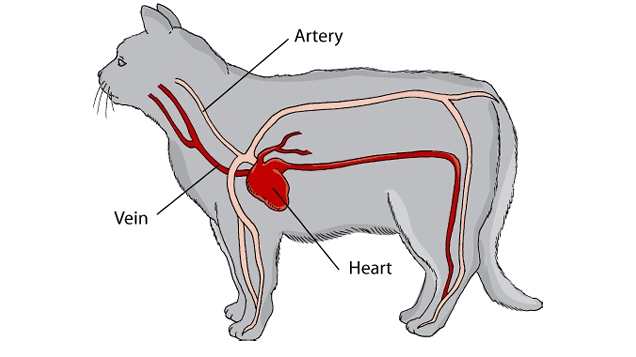
Feline heart, veins and arteries
Source: https://www.msdvetmanual.com/cat-owners/heart-and-blood-vessel-disorders-of-cats/introduction-to-heart-and-blood-vessel-disorders-in-cats
Cost of heart disorder in cats*
Average claim cost |
Highest claim cost |
No of dogs affected in 2022 |
| $1,060 | $6,764 | 119 |
* PetSure claims data for heart disorder experienced by cats in 2022
Because it is difficult to predict the costs of veterinary care, it can help to have measures in place to help prepare for the unexpected. Pet insurance can help by covering a portion of the eligible vet bill if the unexpected does happen.
Get a quote for 2 months free pet insurance for your puppy or kitten in their first year.
Symptoms of cardiac disease in cats
In the early stages of feline heart disease, there may be no visible signs that there are any problems. Cats generally manage to cope despite the onset of heart disease because of well-developed compensatory mechanisms and by altering their activity levels. Unlike initial symptoms of heart disease in dogs like coughing, lethargy and panting, in cats it is often not until the disease is well advanced that it is evident there is a problem.
Most of the clinical signs and symptoms that do appear later on are associated with the underlying pathology and complications that can develop secondarily to the heart disease. These include:
- Symptoms caused by inadequate blood flow through the organs and tissues:
- Tiring easily
- Weakness, lethargy
- Fainting
- Weak pulse
- Cold extremities
- Poor circulation
- Exercise intolerance
- Bluish discolouration of foot pads and nail beds
- Symptoms from blood damming up in organs:
- Leakage of fluid from blood vessels into tissues
- Abnormal accumulation of fluid in the lungs or abdomen
- Symptoms caused by fluid retention inside or outside the lungs:
- Difficulty breathing
- Short, rough, crackling breathing sounds
- Increased respiratory rate
- Coughing
- Symptoms from a lack oxygen in the blood:
- Pale or blue-tinged mucous membranes
- Increased concentration of red blood cells
- Symptoms of thromboembolic disease:
- Clots in the arteries
- Dragging rear limbs
- Sudden hind-limb paralysis
- Cold rear limbs
- Sudden lameness
- Vocalising, from pain
- Other generalised symptoms of heart disease cats include:
- Abnormal heart sounds (i.e., muffled, galloping rhythm, murmurs)
- Oedema or swelling of the limbs
- Weight loss (cardiac cachexia)
- Depression
- Blindness
- Collapse
- Jugular vein pulses
- Sudden heart failure
- Symptoms of congestive heart failure include:
- Difficulty breathing or rapid breathing
- Lethargy
- Loss of appetite
- Panting or open-mouth breathing, which is a clear sign of distress
- Blue or grey tongue and gums
- Collapse
- Hind limb paralysis
- Sudden death
Causes of cardiac disease in cats
Primary heart disease in cats is often a hereditary condition passed on from parents or grandparents or a congenital abnormality that is present from birth. However, there are many secondary causes of heart disease in cats. These include:
Abnormalities of the cardiovascular system leading to heart disease
- Valve disease – the heart valves fail to open or close properly
- Myocardial disease – the heart muscle pumps too weakly or relaxes inadequately
- Arrhythmia – the heart beats too slowly, too rapidly or irregularly
- Vascular disease – the blood vessels offer too great an interference to blood flow
- Cardiac shunts – openings between the left and right chambers of the heart
- Extra-cardiac shunts – abnormal blood flow between the body and the lungs
- Parasitism of the cardiovascular system, e.g. heartworm disease
Significant secondary causes of or contributors to heart diseases in cats
- Hyperthyroidism – the most common underlying cause of a cardiomyopathy
- Kidney failure
- Dietary deficiency of taurine, an essential nutrient
- Hypertension
Causes of congestive heart failure (CHF) in cats
While there are many causes of congestive heart failure in cats, it is most commonly the result of hypertrophic cardiomyopathy. Common causes of CHF in cats include:
- Hypertrophic cardiomyopathy
- Hyperthyroidism
- High blood pressure
- Birth defects
- Heart valve disorders
- Heart wall disorders
- Fluid in the heart sac
- Blood clots in the heart
- Heartworm disease
- Tumours
- Anaemia
How is cardiac disease in cats diagnosed?
The diagnosis of heart disease in cats typically involves evaluating the symptoms, history and physical examination findings, as well as results of diagnostic tests such as radiography, electrocardiography and echocardiography. Occasionally, more specialised tests such as cardiac catheterisation, CT, MRI, or nuclear studies are required.
Cats do not make things easy when evaluating the canine heart. From the physical exam to screening tests, cats can thwart our best attempts to diagnose heart disease before symptoms are evident. Therefore, it is important to be aware of the subtleties of feline heart disease and look out for warning signs of any potential indication of heart problems in cats. You can assist by providing a thorough history of your cat’s health leading up to the onset of symptoms, including any information you have about your cat’s genetic background.
Detection of abnormal heart sounds
By listening to your cat’s heart with a stethoscope, a vet can detect an arrhythmia or a heart murmur up to a year or so in advance of heart disease and there is a 85-90% chance of finding early heart disease in a cat.
The finding of a heart murmur alone is insufficient for determining the presence or absence of heart disease in cats. Even with heart disease severe enough to cause congestive heart failure, only half of affected cats will exhibit heart murmurs. Detecting other abnormal heart sounds, such as gallop sounds and arrhythmias, may be of diagnostic benefit, as these may improve the sensitivity and specificity of the diagnosis.
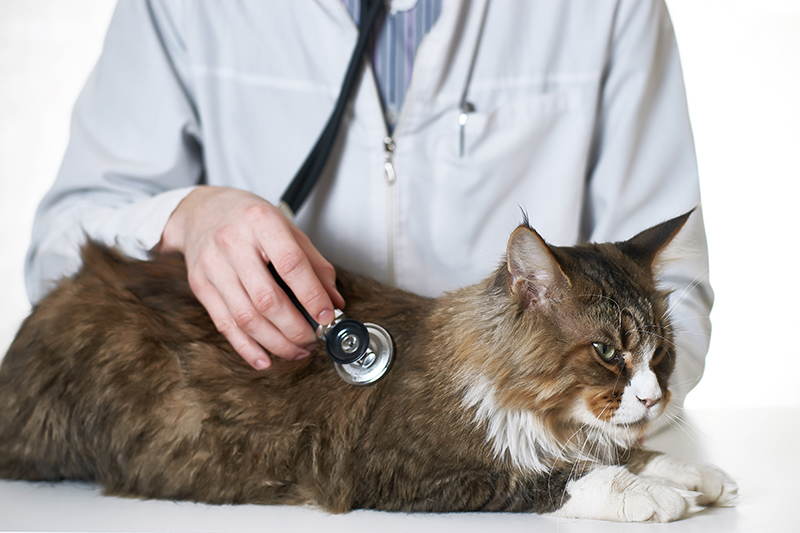
Cardiac disease in cats: Diagnosis of heart disease in cats
Electrocardiogram
An electrocardiogram (EKG, ECG) is used to assess the heart rhythm if an arrhythmia is suspected. An EKG recording allows examination of the electrical currents in the heart muscles and may reveal any abnormalities in its electrical conduction (which underlies the heart’s ability to contract/beat). While an EKG can help your vet to determine the origin of detected abnormal heart rhythms, it may not be adequate for a definitive diagnosis of feline heart disease.
Echocardiogram
Echocardiography, an ultrasound exam to evaluate heart structure and function, is the most important test for the diagnosis of hypertrophic cardiomyopathy in cats. Echocardiography allows visualisation of the inside of the heart in real time, so that heart chambers and walls can be measured. Left ventricular heart walls that are thicker than 6mm are indicative of HCM.
Radiography
Radiograph imaging (x-rays) is useful for visually examining the heart for enlargement or thickening of the walls, or for thickening of the mitral valve (which controls the flow of blood between the left ventricle and the left atrium). If a cat has rapid or difficult breathing, chest radiographs can aid in determining if congestive heart failure is present.
Blood tests
Blood tests can be used to screen for or further investigate heart disease in cats. Biomarker testing is a new frontier in blood testing for assessing the heart; in particular, the proBNP test measures cardiac stretch that occurs with heart disease. A positive result suggests the presence of moderate to severe heart disease, however a negative result may fail to identify mild heart disease. BNP testing is also useful for testing cats whose family members have been diagnosed with heart disease.
Diagnosing hypertrophic cardiomyopathy (HCM)
An accurate diagnosis of hypertrophic cardiomyopathy is a process of careful elimination. Echocardiography (ultrasound of the heart) is the most important test for the diagnosis of HCM in cats.
Because HCM is inherited in many purebred cats and presumed inherited in mixed breed cats, all cats related to an affected cat should be screened for the disease with echocardiography regardless of whether or not they have a heart murmur.
Diagnosing congestive heart failure (CHF)
Congestive heart failure is usually diagnosed based on symptoms and physical examination findings, such as the presence of fluid in the lungs detected by a stethoscope. To definitively diagnose CHF and determine its cause, your vet will usually perform a number of tests, such as:
- Blood and urine tests, including complete blood count, biochemical panel, thyroid hormone test, heartworm test, FeLV/FIV test, and urinalysis
- Chest radiographs (x-rays) to assess the heart, blood vessels, and lungs
- An electrocardiogram
- An echocardiogram
- Blood pressure measurements
High blood pressure and high thyroid concentrations are two conditions which mimic hypertrophic cardiomyopathy and should be eliminated as other possible causes of thickening of the heart walls. Your cat will need to have its blood pressure measured in order to rule out hypertension, and its blood will be tested for high levels of thyroid hormones. Hyperthyroidism exhibits may of the same symptoms as HCM, such as lethargy, short breath, and irregular heart rhythm.
Life expectancy
Hypertrophic cardiomyopathy is usually a slowly progressive disease over years, although some cats may show rapid progression over months. If no significant deterioration is observed several months after the initial diagnosis, cats with mild HCM are usually rechecked annually for progression or development of complications. Although cats with mild disease will need to be monitored, some cats will not experience complications from their disease.
The prognosis for cats with advanced heart disease that have succumbed to congestive heart failure or thromboembolism is highly variable, with some cats surviving only days or weeks and others responding well to medications and living for more than a year or two. The average survival time for a cat with congestive heart failure is 12-18 months and for a cat with thromboembolism it is about 6 months. (Note that these are average survival times based on large groups of cats. While these times can provide an indication of what to reasonably expect, they do not predict an individual cat’s survival time.)
Treatment for cardiac disease in cats
Treatment options for feline heart disease will be determined by the vet after careful consideration of the symptoms and causal factors. Where the heart disease is secondary to another disorder, such as congestive heart failure that is caused by hyperthyroidism, treatment of the underlying condition may resolve some or all of the heart problems. If the problem is caused by a congenital condition (a heart defect that the cat has had since birth), treatment may be surgical repair. In most cases, however, heart disease cannot be cured. Nonetheless, treatment can almost always help improve quality and length of life.
Treatment of hypertrophic cardiomyopathy in cats
If there is a diagnosis of hypertrophic cardiomyopathy your cat may be hospitalised for appropriate care, especially if it is suffering from congestive heart failure, which is a common outcome of this disease. In hospital, the cat will be placed in a quiet environment to minimise stress, and if it is having breathing difficulties it will be given oxygen therapy. If the cat’s body temperature is low, it will be warmed with blankets.
There are several possible medications that can be used to treat hypertrophic cardiomyopathy, depending on the advancement of the disease, including:
- Diltiazem, a heart and blood pressure medication, used to slow the heart rate, treat cardiac arrhythmias and hypertension and possibly reduce the enlargement in the left ventricle
- Beta blockers (or calcium channel blockers), to slow the heart rate, correct irregular rhythms, and control blockage of the blood flow (these are not used if the cat has congestive heart failure)
- ACE inhibitors, in cases with congestive heart failure, to improve the flow through the ventricle
- Anti-thrombotic treatment such as low-dose aspirin, to decrease risk of clot formation
- Anticoagulants, such as Warfarin, to prevent blood clotting
- Diuretics, to remove excess fluid from the body
- Nitro-glycerine ointment, to improve flow by dilating (opening) the ventricle and arteries
Is Warfarin safe for my cat?
There is some confusion around Warfarin as it is used both as a pharmaceutical drug and a rodent poison. The pharmaceutical drug Warfarin Sodium, also known by the brand name Coumadin®, is an anticoagulant used primarily to treat and prevent blood clots in humans, dogs and cats. It is often prescribed for cats with cardiomyopathy to prevent formation of clots in the left atrial chamber of the heart. These clots can break off and impair blood flow to the back legs. While generally safe and effective when prescribed by a veterinarian, Warfarin can cause side effects in some animals. The most significant adverse effect is bleeding because of difficulties in dosing this drug in cats. This bleeding can be quite serious and even fatal if not controlled. Medication should never be administered without first consulting your veterinarian.
The poison, Warfarin rodenticide, sold under brand names such as Bar Bait, Contrax-W, Co-Rax, Coumafene, Cov-R-Tox and Denkarin, is an over-the-counter poison used to kill mice, rats, and other pests. Anticoagulants are commonly used in rodent poisons, accounting for a large number of accidental poisoning in cats. This usually occurs when the poison is placed in and around buildings without protective bait stations, allowing access to the poison by cats and other unintended animals. When ingested, anticoagulants block the synthesis of vitamin K, an essential component for normal blood clotting, resulting in spontaneous and uncontrolled bleeding.
Treatment for mild hypertrophic cardiomyopathy in cats
The benefit of treatment for cats in the asymptomatic, mild phase of HCM has not been well studied. Whether treatment is initiated depends on the specific echocardiographic changes such as the presence or absence of left ventricular obstruction, other health conditions, the temperament of the cat and cost factors. Medical treatment at this stage mainly consists of beta blockers. No treatment is an option for some cats in this phase. Cats should have their echocardiogram rechecked within 3 to 6 months to monitor progression of the disease. If no changes are noted, either bi-annual or annual echocardiographic evaluation is recommended.
Treatment for advanced hypertrophic cardiomyopathy in cats
If a cat has more advanced changes such as left atrial enlargement, then anti-thrombotic treatment (e.g. low dose aspirin) will probably be recommended to reduce the risk of clot formation, even if the cat does not have obvious signs of heart disease.
Treatment of cats with heart failure resulting from HCM involves the use of diuretics, anti-thrombotic medications and sometimes ACE-inhibitor medications. Affected cats require close monitoring by both owner and vet to ensure optimal management of their disease. This will typically involve a re-evaluation of bloodwork, blood pressure and possibly chest X-rays soon after starting medications, and then approximately every 3 months thereafter.
Treatment of congestive heart failure in cats
Cats with severe congestive heart failure may require initial hospitalisation and oxygen therapy. If fluid is affecting the lungs or is found in the sac surrounding the heart or the chest cavity, it may need to be removed to improve breathing and help the heart pump more efficiently.
Medications will be prescribed to help reduce fluid build-up, improve heart function and normalise heart rhythms. Most cats with congestive heart failure require medications for the remainder of their lives. A low-sodium diet may be recommended to help prevent fluid accumulation. Periodic blood tests, radiographs, and echocardiograms are often needed to monitor treatment success and disease progression.
Treatment of thromboembolic disease
Treatment of cats with thromboembolic disease initially includes supportive therapy such as pain control, anti-clotting medications and physical therapy. Some cats will regain function of the affected limbs while others will not and may succumb to this complication of their heart disease. Medications such as anticoagulants (e.g. low dose aspirin) and anti-platelet medication are typically prescribed to help reduce the risk of future thromboembolic episodes.
Cats that have experienced thromboembolism require close monitoring by both owner and vet to ensure optimal management of their disease. This will characteristically involve repeated evaluations of bloodwork, blood pressure and possibly chest X-rays within a week of starting medications, and then approximately every 3 months thereafter.
Follow up / ongoing treatment for heart disease in cats
Ongoing medical testing
If your cat is being treated with the anticoagulant Warfarin, its blood will need to be tested to determine whether the drug is effectively decreasing the likelihood of a blood clot. Use of Warfarin can also lead to uncontrolled bleeding and bruising. You will need to take care that your cat is kept from activities that may lead to injury while it is taking this medication.
If your cat is taking an ACE inhibitor, or spironolactone, kidney function and electrolytes will need to be monitored. After six months, a repeat ultrasound examination of the heart will be required to determine progress, and whether further treatment will be required.
Ongoing home monitoring
Ongoing at home monitoring is critical for detecting problems that would prompt re-evaluation. In particular, monitoring for breathing difficulties, weakness, lethargy, hind-limb paralysis, loss of appetite and daily assessment of resting breathing rate can be extremely helpful for the early detection of congestive heart failure or recurrence thereof.
Breathing rate should be measured at rest or during sleep (making certain that the cat is not purring) by counting the number of breaths over 30 seconds and multiplying by 2 to obtain a per-minute rate. Normal breathing rate is less than 36 per minute. A rate that is consistently higher than this or a significant change from baseline for an individual cat should prompt re-evaluation by a veterinarian. (Note that mobile apps are available for smartphones that can assist with breathing rate measurement and tracking.)
Lifestyle changes
The cat should be put on a sodium-restricted diet, especially if there is congestive heart failure, to keep the pressure in the blood stable.
Environmental stress may activate the nervous system, placing excess stress on the already overstressed left ventricle, and possibly leading to heart failure. Therefore, providing a quiet and safe space for your cat, away from other pets and active children, is important to its recovery.
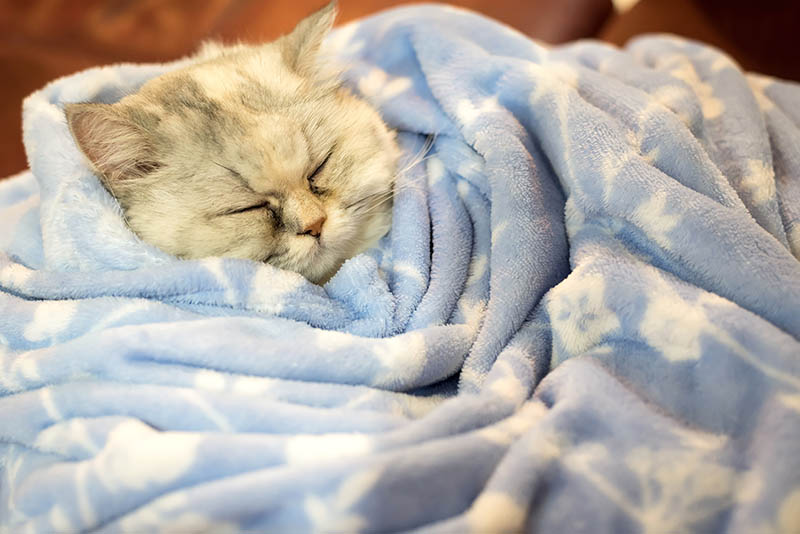
Overview
Heart disease is the silent killer of cats, and one in six cats can be born with or develop heart disease in their lifetime. Although there does appear to be a genetic predisposition to feline heart disease, all cats from the very young to the really old can suddenly be affected.
Often there are no symptoms until the disease is well advanced, therefore, the most important thing the owner can do is take your cat to the vet at least once a year for a heart check, which can detect a heart murmur and/or an arrhythmia. A baseline proBNP blood test should also be considered. Though many cats with heart disease have normal ECGs, the presence of an arrhythmia can be indicative of heart disease. Early recognition and treatment can facilitate appropriate clinical management and a long, relatively healthy, life.
The most common outcome of undetected heart disease in cats is sudden respiratory distress and sudden death. This end stage of heart disease is often a chest congested with fluid that restricts their lungs from expanding and impairs their breathing. Sadly, there is no known means of prevention of feline congestive heart failure except through judicious breeding programs designed to eliminate any hereditarily affected animals from the gene pool.
Bow Wow Meow Pet Insurance can help protect you and your cat should an unexpected trip to the vet occur.
-
Find out more about our cat insurance options
-
Get an online pet insurance quote


More information
https://www.vetwest.com.au/pet-library/heart-disease-cardiomyopathy-in-cats
https://www.medvetforpets.com/subtle-indications-pre-clinical-heart-disease-cats/
https://www.medvetforpets.com/feline-hypertrophic-cardiomyopathy-hcm/
https://www.petmd.com/cat/conditions/cardiovascular/c_ct_cardiomyopathy_hypertrophic
https://www.cathealth.com/cat-health/cardiovascular/1666-heart-disease-in-cats
https://www.petmd.com/cat/conditions/cardiovascular/c_ct_heart_murmur
http://www.vetstreet.com/care/congestive-heart-failure-chf-in-cats
https://www.bellemeadanimalhospital.com/exciting-new-blood-test-for-cats-to-detect-heart-disease/
http://www.pethealthnetwork.com/cat-health/cat-diseases-conditions-a-z/aortic-thromboembolism-cats
http://catdoctor.com.au/cat-health/cardiomyopathy-heart-disease/
https://vcahospitals.com/know-your-pet/rodenticide-warfarin-poisoning-in-cats

